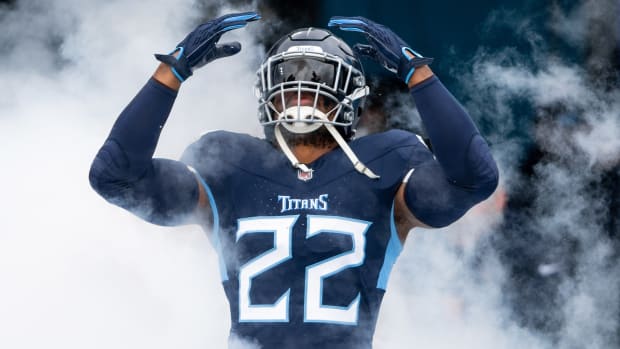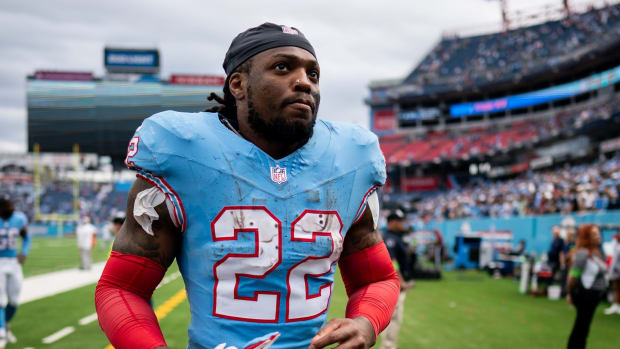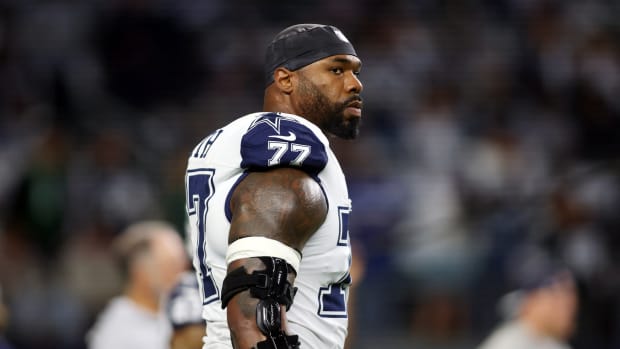Crunching Numbers With Salary Cap Set
The NFL set the 2021 salary cap last week at 182.5 million, the first drop since the current collective bargaining agreement went into effect in 2011 and a significant one at that. The 2020 cap was $198.2 million.
General manager Jon Robinson managed the Tennessee Titans’ finances well enough last year that they carried over $8,045,697, which makes $190,545,687 their adjusted cap number for the coming campaign.
A look at how the current makeup of the roster figures into the number (salary figures according to OverTheCap.com):
• Last year’s big deals: Quarterback Ryan Tannehill and running back Derrick Henry got big-money extensions last year that paid immediate dividends. However, those two are going to cost the Titans a significant chunk of their salary cap this year. Tannehill has the team’s highest cap number at $29.5 million, and Henry is fifth at $13.5 million. That’s a combined $43 million between those two, which eats up 22.6 percent of their actual cap number.
By comparison, in 2020 Tannehill ($22.5 million) and Butler ($13.6 million) had the top two cap hits and took up just 16.4 percent of the actual cap space. In 2019, it was Marcus Mariota ($20.922 million) and left tackle Taylor Lewan ($13.288 million) at the top, and they exhausted 15.7 percent of the actual cap space.
The challenge for Robinson and his staff this year will be to find quality, affordable depth for what is – by far – the most top-heavy roster of his tenure.
• Bucks for blockers: Last week’s decision to trade Isaiah Wilson to the Miami Dolphins effectively assures that Dennis Kelly will be the starting right tackle for a second straight year. That means four of the top eight current cap numbers belong to starting offensive linemen.
Kelly will count $8.33 million against the cap in the second year of three-year pact he signed last offseason, which is third to Lewan ($13.696 million) and left guard Rodger Saffold ($12.344 million) and just ahead of center Ben Jones ($7.25 million). Those four players account for 21.8 percent of the actual cap space.
Combined with the Tannehill and Henry deals, the investment in offense is significant, to say the least.
• Bang for the buck: What typically separates a team from the pack is the ability to get big-time performances from guys who don’t get paid a lot, i.e. those still on their rookie contracts. Number-one among the Titans’ bargains is wide receiver A.J. Brown, their top pass catcher each of the last two years and a 2020 Pro Bowler. Brown, a second-round pick in 2019, will count just $1.541,555 against the cap this year.
Right guard Nate Davis, the third-round selection in 2019, is another guy who offers a sizable payoff relative to the investment. A starter since early in his rookie season, his cap hit for 2021 will be $1.084 million, which makes him the lone exception among the starting offensive linemen.
The most important player in this regard, though, could be last year’s second-round selection, cornerback Kristian Fulton. With Butler’s release, Fulton almost certainly will have a big role – likely a starter – on the defense, and at a $1.211 million cap hit, it will be up to him to deliver a notable payoff.
• There’s a catch: There is penny pinching, and then there are just plain pennies, which – relatively speaking – is what Tennessee currently has committed to wide receivers other that Brown.
Adam Humphries has been released, and Kalif Raymond won’t be tendered. The idea of re-signing Corey Davis, the fifth overall pick in 2017, while appealing, is not prudent. Analysts project that Davis could secure a deal worth just under $10 million per season. For that kind of money Tennessee can – and should – sign multiple players at that position.
As it stands right now, Brown is one of seven wide receivers under contract for 2021. Each of the other six are set to earn the minimum, based on their experience. Between them, those six have 177 career receptions, while Brown has 122 on his own.
• First-round fees: With Wilson in Miami and Davis presumably on his way to a new team, four of the franchise’s recent first-round picks remain on the roster. They are Lewan (2014), cornerback Adoreé Jackson (2017), linebacker Rashaan Evans (2018) and defensive tackle Jeffery Simmons (2019). Lewan is on his second NFL contract, while Jackson is in the option year of his rookie deal, which means a sizable pay increase – to $10.244 million, in his case. The other two remain relatively affordable within the first four years of their rookie contracts.
Together, those four will count 31.078 million against the salary cap, which is just over $1.5 million more than Tannehill’s cap hit alone.
• Money to spend: With mere days remaining before the start of the new league year, the Titans have $15,853,041 in effective salary cap space. There are 18 teams that have more to spend, including the other three in the AFC South – Jacksonville ($72,877,714), Indianapolis ($45,889,614) and Houston ($16,967,346) – as well as the team that ended Tennessee’s 2020 season, Baltimore ($20,150,890), and one other of last season’s AFC playoff teams, Cleveland ($24,074,244).
Robinson and his staff will have to be efficient with their spending and they cannot – to say the least – afford the types of misses that they made last year.




